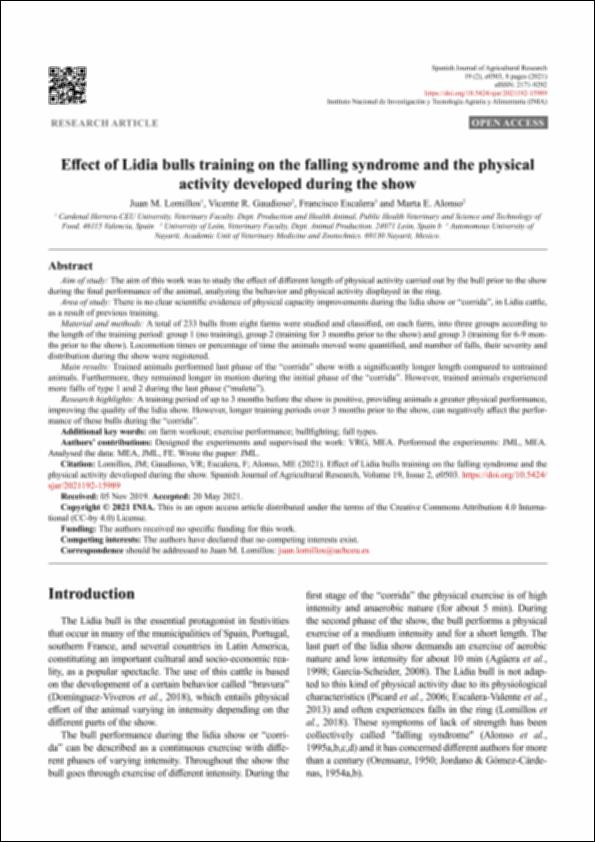Por favor, use este identificador para citar o enlazar este ítem:
http://hdl.handle.net/10637/13486Effect of Lidia bulls training on the falling syndrome and the physical activity developed during the show
| Título : | Effect of Lidia bulls training on the falling syndrome and the physical activity developed during the show |
| Autor : | Lomillos Pérez, Juan Manuel Gaudioso Lacasa, Vicente R. Escalera Valente, Francisco Alonso de la Varga, Marta Elena |
| Materias: | Bienestar animal.; Fighting bull - Breeding.; Toros de lidia - Cría y explotación.; Animal welfare. |
| Editorial : | Instituto Nacional de Investigación y Tecnología Agraria y Alimentaria (INIA) |
| Citación : | Lomillos, J.M., Gaudioso, V.R., Escalera, F. & Alonso, M.E. (2021). Effect of Lidia bulls training on the falling syndrome and the physical activity developed during the show. Spanish Journal of Agricultural Research, vol. 19, n. 2 (08 jun.), art. e0503. DOI: https://doi.org/10.5424/sjar/2021192-15989 |
| Resumen : | Aim of study: The aim of this work was to study the effect of different length of physical activity carried out by the bull prior to the show during the final performance of the animal, analyzing the behavior and physical activity displayed in the ring. Area of study: There is no clear scientific evidence of physical capacity improvements during the lidia show or “corrida”, in Lidia cattle, as a result of previous training. Material and methods: A total of 233 bulls from eight farms were studied and classified, on each farm, into three groups according to the length of the training period: group 1 (no training), group 2 (training for 3 months prior to the show) and group 3 (training for 6-9 months prior to the show). Locomotion times or percentage of time the animals moved were quantified, and number of falls, their severity and distribution during the show were registered. Main results: Trained animals performed last phase of the “corrida” show with a significantly longer length compared to untrained animals. Furthermore, they remained longer in motion during the initial phase of the “corrida”. However, trained animals experienced more falls of type 1 and 2 during the last phase (“muleta”). Research highlights: A training period of up to 3 months before the show is positive, providing animals a greater physical performance, improving the quality of the lidia show. However, longer training periods over 3 months prior to the show, can negatively affect the performance of these bulls during the “corrida”. |
| Descripción : | Este artículo se encuentra disponible en la siguiente URL: https://sia.revistas.inia.es/index.php/sjar/article/view/15989/5171 |
| URI : | http://hdl.handle.net/10637/13486 |
| Derechos: | http://creativecommons.org/licenses/by/4.0/deed.es |
| ISSN : | 2171-9292 (Electrónico) |
| Fecha de publicación : | 8-jun-2021 |
| Centro : | Universidad Cardenal Herrera-CEU |
| Aparece en las colecciones: | Dpto. Producción y Sanidad Animal, Salud Pública Veterinaria y Ciencia y Tecnología de los Alimentos |
Los ítems de DSpace están protegidos por copyright, con todos los derechos reservados, a menos que se indique lo contrario.


